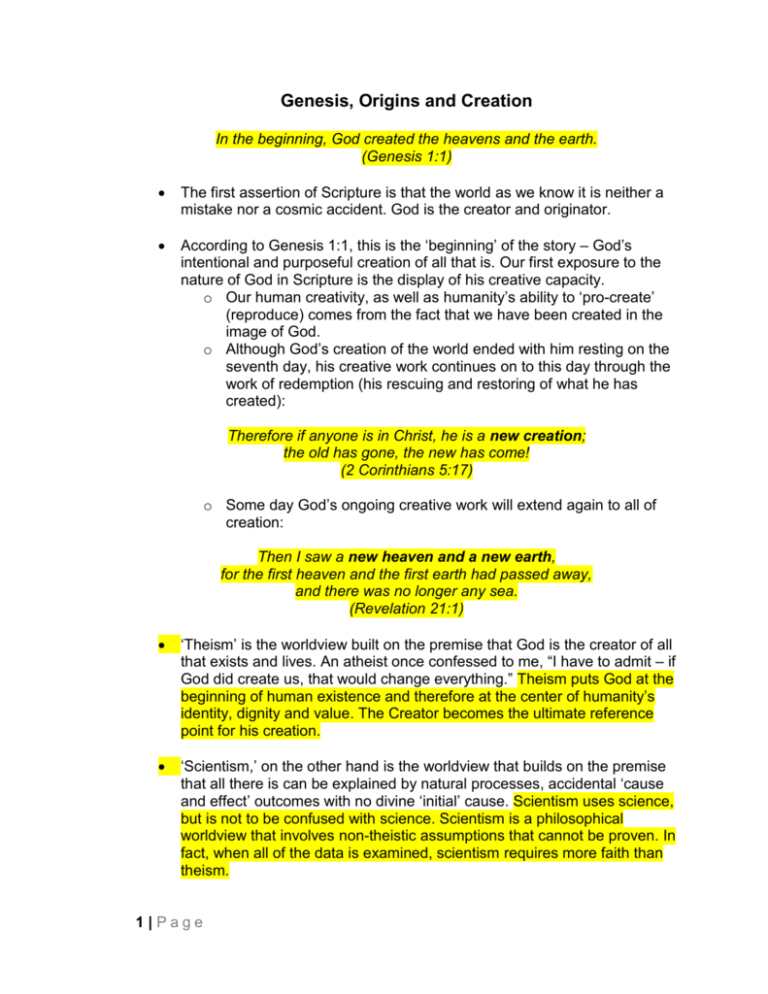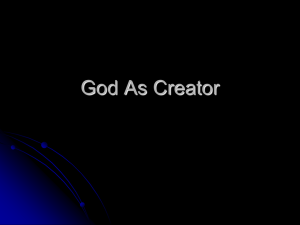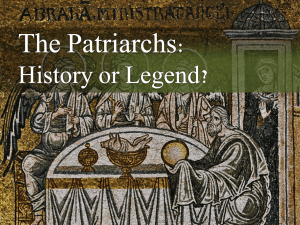notes
advertisement

Genesis, Origins and Creation In the beginning, God created the heavens and the earth. (Genesis 1:1) The first assertion of Scripture is that the world as we know it is neither a mistake nor a cosmic accident. God is the creator and originator. According to Genesis 1:1, this is the ‘beginning’ of the story – God’s intentional and purposeful creation of all that is. Our first exposure to the nature of God in Scripture is the display of his creative capacity. o Our human creativity, as well as humanity’s ability to ‘pro-create’ (reproduce) comes from the fact that we have been created in the image of God. o Although God’s creation of the world ended with him resting on the seventh day, his creative work continues on to this day through the work of redemption (his rescuing and restoring of what he has created): Therefore if anyone is in Christ, he is a new creation; the old has gone, the new has come! (2 Corinthians 5:17) o Some day God’s ongoing creative work will extend again to all of creation: Then I saw a new heaven and a new earth, for the first heaven and the first earth had passed away, and there was no longer any sea. (Revelation 21:1) ‘Theism’ is the worldview built on the premise that God is the creator of all that exists and lives. An atheist once confessed to me, “I have to admit – if God did create us, that would change everything.” Theism puts God at the beginning of human existence and therefore at the center of humanity’s identity, dignity and value. The Creator becomes the ultimate reference point for his creation. ‘Scientism,’ on the other hand is the worldview that builds on the premise that all there is can be explained by natural processes, accidental ‘cause and effect’ outcomes with no divine ‘initial’ cause. Scientism uses science, but is not to be confused with science. Scientism is a philosophical worldview that involves non-theistic assumptions that cannot be proven. In fact, when all of the data is examined, scientism requires more faith than theism. 1|Page When Einstein was developing his theories of general and specific relativity a century ago, the scientific community believed in the ‘steady state’ nature of the universe – that the cosmos had no beginning and presumably no end. However, to Einstein’s surprise, his field equations for general relativity indicated a beginning point to the universe, which he found theologically unsettling and scientifically unpopular. o In order to counter this, Einstein arbitrarily added an anti-gravity term (the cosmological constant) to one side of the relativity equations in order to make them predict what he wanted -- a steady state universe. This was scientism over science. o Einstein later removed the term and called its insertion the ‘greatest blunder’ of his scientific career. o Today it is largely unquestioned in the scientific community that, in spite of the theistic implications and unanswered ‘how’ questions, our universe does have a specific starting point. Here we find some initial common ground between science as it presently stands and Genesis 1:1. Creation and the Trinity The first verse of Genesis 1 indentifies ‘God’ as the intentional creator of the heavens and the earth, the ultimate ‘first cause.’ The second verse of Genesis 1 references the Holy Spirit as hovering over our initially dark and formless planet: Now the earth was formless and empty, darkness was over the surface of the deep, and the Spirit of God was hovering over the waters. (Genesis 1:2) In the third verse of Genesis 1 there is reference to ‘word’ – God spoke the word and creative activity resulted. And God said, “Let there be light,” and there was light. (Genesis 1:3) o The ‘word’ of creation, however, takes on specific identity in the New Testament the with incarnation of Christ. In the beginning was the Word, and the Word was with God, and the Word was God. He was with God in the beginning. Through him all things were made; without him nothing was made that has been made. . . . 2|Page And the Word [Jesus] became flesh and made his dwelling among us. (John 1:1-3, 14a) He [Jesus] is the image of the invisible God, the firstborn over all creation. For by him all things were created: things in heaven and on earth, visible and invisible, whether thrones or powers or rulers or authorities; all things were created by him and for him. He is before all things, and in him all things hold together. (Colossians 1:15-17) In these last days, he [God] has spoken to us by his Son [Jesus], whom he appointed heir of all things, and through whom he made the universe. The Son is the radiance of God’s glory and the exact representation of his being, sustaining all things by his powerful word. (Hebrews 1:2-3a) The interplay of Father, Son and Holy Spirit in the creation event demonstrates the all-encompassing investment that God has made in his creation, just as he later does in the redemption of creation. We are not a mistake, and we are not abandoned. It is as if human beings carry a sign hung around their necks, “Made in the image of God – handle with care.” o This redefines how we view ourselves, how we treat others and how we make moral decisions. o If, on the other hand, we are just cosmic accidents, we are not only unredeemable but we have no definable worth independent of the utilitarian social standards or the human prejudices of the majority. This makes us little more than victims. o The American Declaration of Independence got it right: “We hold these truths to be self-evident, that all men are created equal, that they are endowed by their Creator with certain unalienable Rights.” Fine Tuning Evidence for a Creator The world-famed British theoretical physicist, Stephen Hawking expressed it this way (A Brief History of Time, p. 125) “The laws of science as we know them at present, contain many fundamental numbers, like the size of the electric charge of the electron and the ratio of the masses of the proton and the electron. . . . The remarkable fact is that the values of these numbers seem to have been very finely adjusted to make possible the development of life.” 3|Page One of my favorite illustrations of this is the nuclear fusion fueling the heart of our sun’s furnace. The process involves two deuterium nuclei (a deuteruim nucleus has one proton and one neutron) fusing to form one helium nucleus (two protons and two neutrons). However, the mass of the helium nucleus is 99.3 percent of the mass of the two deuterium nuclei. According to Einstein’s famous equation E=mc2 (where E is energy, m is mass and c is the speed of light), this slight differencial in mass is converted into large amounts of energy (the principle behind atomic bombs). o If the mass difference were 99.4 percent, stars would shine too dimly to support life. o If the mass difference were 99.2 percent, too much energy would be given off to allow for star formation in the first place. Dr. Francis Collins, the American geneticist who first sequenced the human genome, explains in more detail: “When you look from the perspective of a scientist at the universe, it looks as if it knew we were coming. There are 15 constants – the gravitational constant, various constants about the strong and weak nuclear force, etc. – that have precise values. If any one of those constants was off by even one part in a million, or in some cases, by one part in a million million . . . matter would not have been able to coalesce, there would have been no galaxy, stars, planets or people.” In his book, A Case Against Accident and Self-Organization, Dean Overman examines some of these constants and their necessarily precise relationships to one another. Here are just a few: o “If the strong nuclear force were only 2 percent stronger, two protons could bind despite their electrically charged repulsions, and . . . the universe would consist mainly of helium and very little hydrogen. Hydrogen, of course, was necessary for the formation of the sun and the formation of liquefied water, both necessary for the formation of life. . . . A 2 percent decrease in the strength of this force, on the other hand, would render unstable certain of the heavy elements which are prerequisites for life.” (p. 133) o “The strength of the force of gravity precisely matches the strength of the electromagnetic force to allow for the formation of a star such as the sun. . . If the electromagnetic force were only slightly stronger, all stars would be red and too cold for the emergence of life. If the force of electromagnetism were slightly weaker, all stars 4|Page would be extremely hot blue giants which would burn out before life could emerge from any planet orbiting a star.” (p. 134,135) o “For the existence of life, the number of electrons must be meticulously balanced to an accuracy of one part in 1037 with the number of protons. Without this balance the force of gravity which was essential to the formation of stars and planets would have been overwhelmed by the electromagnetic force.” (p. 136) o “The electromagnetic force binds protons and electrons in atoms. An electron’s path around an atom’s nucleus governs the ability of the atom to bond with another atom in the formation of molecules. If the electromagnetic force were slightly increased in strength, an atom would not share an electron with other atoms and molecules would not form. If the force were slightly weaker, the electrons would not remain in their paths around an atom’s nuclei. Accordingly, any change in the strength of the electromagnetic force would preclude the formation of life.” (p. 136) Astrophysicist Hugh Ross, in his book The Fingerprint of God, suggests that over 30 parameters in the sun-earth-moon system alone also must come into precise alignment for life to exist on planet earth. He estimates that the odds of this happening are remotely small – “much fewer than a trillionth of a trillionth of a percent of all stars will have a planet capable of sustaining advanced life.” Here are just a few of those parameters: o Parent star distance from the center of the galaxy If farther: quantity of heavy elements would be insufficient to make rocky planets. If closer: stellar density and radiation would be too great. o Surface gravity If stronger: atmosphere would retain too much ammonia and methane. If weaker: planet’s atmosphere would lose too much water. o Axial tilt If greater: surface temperature differences would be too great. If less: surface temperature differences would be too great. o Gravitational interaction with a moon If greater: tidal effects on the oceans, atmosphere, and rotational period would be too severe. If less: orbital obliquity changes would cause climatic instabilities. o Magnetic field If stronger: electromagnetic storms would be too severe. If weaker: inadequate protection from hard stellar radiation. o Thickness of crust 5|Page If thicker: too much oxygen would be transferred from the atmosphere to the crust. If thinner: volcanic and tectonic activity would be too great. o Seismic activity If greater: too many life-forms would be destroyed. If less: nutrients on ocean floors would not be recycled to the continents through tectonic uplift. “You have a better chance of winning the California lottery 140 consecutive times where you purchase just one ticket each time than of getting a human-life-supporting planet or moon via naturalistic means!” (Ross, Anthropic Principle vs Prebiotic Principle, Reasons.org, Dec. 13, 2010) PPT video – from Testoffaith.com, “Fine Tuning” The astronomer and mathematician Fred Hoyle (Cambridge University), an atheist, calculated the odds of 2000 enzymes, each performing specific tasks necessary to form a single bacterium like E. coli, to be one in 1040,000. He once wrote: “A common sense interpretation of the facts suggests that a superintellect has monkeyed with physics, as well as with chemistry and biology, and that there are no blind forces worth speaking about in nature. The numbers one calculates from the facts seem to me so overwhelming as to put this conclusion almost beyond question.” Biochemist, geneticist and agnostic, Michael Denton, sums it up well in his book Evolution: A Theory in Crisis . . . (p. 342) “To grasp the reality of life as it has been revealed by molecular biology, we must magnify a cell by a thousand million times until it is 20 kilometers in diameter and resembles a giant airship large enough to cover a great city like London or New York. What we would then see would be an object of unparalleled complexity and adaptive design. On the surface of the cell we would see millions of openings, like the port holes of a vast space ship, opening and closing to allow a continual stream of materials to flow in and out. If we were to enter one of these openings we would find ourselves in a world of supreme technology and bewildering complexity . . . It is the sheer universality of perfection, the fact that everywhere we look, to whatever depth we look, we find an elegance and ingenuity of an absolutely transcending quality, which so mitigates against the idea of chance. 6|Page “Is it really credible that random processes could have constructed a reality, the smallest element of which – a functional protein or gene – is complex beyond our own creative capacities, a reality which is the very antithesis of chance, which excels in every sense anything produced by the intelligence of man?” Or, as astronomer Robert Jastrow, another agnostic, puts it rather poetically in his book, God and the Astronomers, (p. 250) “For the scientist who has lived by his faith in the power of reason, the story ends like a bad dream. He has scaled the mountains of ignorance; he is about to conquer the highest peak; as he pulls himself over the final rock, he is greeted by a band of theologians who have been sitting there for centuries.” What about Genesis 1? The question as to how God created, and therefore how to understand Genesis 1, is a subject of current debate within the evangelical community. This is probably where the greatest perceived conflict between faith and science exists. o Scientific evidence consistently dates the age of the universe at 13.76 billion years old and the age of the earth at 4.57 billion years old. The majority of scientists also believe that life on earth evolved over vast amounts of time from a ‘prebiotic soup’ to the abundance of life found on the planet today, including human beings. o Numerous questions are raised: Does this contradict Genesis 1? Is Genesis 1 meant to be read as a scientific document? Is Genesis 1 historic or poetic? At stake has been the faith of many people who have wondered if they can trust the rest of Scripture if science appears to contradict the first chapter. o It may be helpful to recall that Scripture and nature are infallible, but our human interpretations of them are not. Our conclusions from Scripture may be wrong (like in the time of Galileo) or science’s conclusions from nature may be wrong (they are constantly under revision as new discoveries emerge). o It is therefore wise not to jettison our faith or give upon the possibility of a relationship with Christ just because we cannot fully reconcile perceived (and possibly inaccurate) conflicts between Genesis 1 and science. In their short book, Christian Perspectives on Origins, Dr. Mike Tenneson (biologist) and Dr. Steve Badger (chemist) outline the three primary points of view regarding the Genesis creation account existent within the Evangelical and Pentecostal worlds today. (p. 17) 7|Page o Young Earth Creationists (YEC) like to call their position “Scientific Creation.” YEC typically interpret the biblical creation accounts as scientifically accurate historical narrative. Thus, they claim that both the Bible and scientific evidences support these conclusions: (1) God suddenly made the physical realm and life, (2) out of nothing, (3) in six consecutive 24-hour periods, (4) about 6,000 – 15,000 years ago. (5) All theories of macroevolution are rejected, (6) as is a universe that is billions of years old. Ken Ham, Duane Gish, and Henry Morris are some of the most widely known adherents of YEC. o Old Earth Creationists (OEC) accept the scientific evidences for a universe that is billions of years old, but they argue that God created everything – including life – by a series of creative acts that took place over a long period of time. This position is also known as “Progressive Creation.” Adherents often disagree on when each of these creative acts occurred. OEC generally reject macroevolution but believe that God directly created life pretty much as it exists today. Creation accounts in the Bible are interpreted as historical narrative but not necessarily as a scientific explanation of how God created. Hugh Ross is probably the most widely known contemporary proponent of OEC. o Evolutionary Creationists (EC) are also known as theistic evolutionists. They accept the scientific evidence for a universe that is billions of years old and embrace contemporary biological theories of evolution, but they stress that God guided the evolution of existing life forms from the original life forms that He created. Creation accounts in the Bible are not thought to be historical narrative or scientifically accurate. EC generally attempt to harmonize theories of macroevolution with the Biblical accounts of origins. Many EC question the existence of a historical Adam and Eve. Francis Collins, Kenneth Miller, Howard J. van Till, and Denis Lamoureux are advocates of EC. With that overview, let us look a little more deeply at each of these three views. Each has its challenges. What is NOT in question with any of their proponents is that God created and that the Scriptures are inspired. o Young Earth Creationism has the majority of scientific evidence against it at face value, but YEC believe that this is the simplest and plainest understanding of the Genesis account. They believe that as science keeps changing the evidence for an earth as young as 6,000 years old will eventually prevail. 8|Page God created the universe with ‘maturity’ built into it, just as he created Adam and Eve as fully developed humans with the immediate appearance of age. This, as well as relativistic effects and possible changes in the speed of light over time, account for being able to see stars today that are millions of light years away. The 6,000 to 15,000 year age of the earth is deduced from the specific genealogies outlined in Genesis, working backwards to Adam and Eve – who are referred to by Jesus and the New Testament readers as literal human beings. Death could not have preceded the fall of Adam and Eve in the garden, and that the whole of the gospel is dependent on a literal understanding of the recorded persons, timelines and events in Genesis. Natural selection (evolution) is biologically impossible, godless, and contrary to the plain reading of Genesis 1. Radiometric dating is inconsistent and ineffective as a dating methodology. The global flood of Noah’s time explains the earth’s present geological formations as well as the fossil record. If the ‘fountains of the deep’ opening up (Genesis 7:11) refers to tectonic activity on the ocean floor, then the global upheavals and shifts in water masses would account for rapid sedimentary layering of the earth’s surface and the instant fossilization of plants and animals. (for more, see The New Creationism: Building Scientific Theory on a Biblical Foundation by Paul Garner) o Old Earth Creationism understands ‘yom’ (the Hebrew word for day’) to mean ‘age’ or ‘era’ and not necessarily a 24-hour solar day. The sun and moon do not appear until the 4th creation ‘day’ and Adam being created, tending the garden, naming animals, experiencing loneliness and having a wife would be too much to fit into 24 hours (Genesis 2). Natural selection (evolution) is rejected due to the rapid appearance of species at certain time intervals. However, Genesis 1 is historically accurate, with the sequence of ‘days’ making perfect sense scientifically if one reads Genesis 1 from the perspective of an observer standing on the earth’s surface: (Hugh Ross, The Fingerprint of God, p. 168) 1. Creation of physical universe; 2. Transformation of earth’s atmosphere from opaque to translucent; 3. Formation of a stable water cycle; 4. Establishment of continent(s) and ocean(s); 5. Production of plants on the continents; 9|Page 6. Transformation of the atmosphere from translucent to transparent; 7. Production of small sea animals; 8. Creation of sea mammals; 9. Creation of birds; 10. Making of land mammals; 11. Creation of mankind. o Evolutionary Creationism does not view Genesis 1 as historic, but as a genre of ancient near-eastern literature written for the purpose of communicating to non-scientifically literate Israelites the truth about God and humanity in contrast to the pagan myths that would have surrounded them. The number 7 was commonly used in a symbolic way to demonstrate completeness and the Genesis 1 account was written with a chiastic, poetic structure: Form Fullness Day 1 Light (day) Darkness (night) => => Sun Moon Day 4 Day 2 Sea Air => => Fish Birds Day 5 Day 3 Land Vegetation => => Creatures Man Day 6 “In summary, Genesis 1 teaches us about the Creator and his work in artistic terms, but does not intend to give us a condensed version of geological history or information about the age of the earth. The Creator has endowed us with the curiosity and skill to figure that out on our own. Moses intended that the divine revelation of Genesis 1 would introduce us to our Creator God.” (Davis A. Young, The Case for an Old Earth – Literary Framework, Enrichment Journal, Fall 2012, p. 81) Here Is What We Know For Sure From Genesis: The universe and everything in it had a beginning; Human history had a beginning and will have an end; There is only one God, and he is Yahweh; God is personally and intimately involved in his creation; God considered the creation good; God created everything – including life – in the physical universe; 10 | P a g e God brought everything into existence for his own purposes; Humans (and only humans) are created in God’s image. God created humans to live in loving relationship with him and with each other; The first humans disobeyed God (sin), destroying our relationship with God; God punished humans for disbelieving and disobeying Him. The rest of Genesis – indeed, the rest of the Bible – reveals God’s great desire for fellowship with humans to be restored. (Badger and Tenneson, Christian Perspectives on Origins, p. 14) THE ASSEMBLIES OF GOD AND THE DOCTRINE OF CREATION (Compiled by Dr. Edgar Lee; presented to the General Presbytery August, 2011) From the beginning, our Fellowship has avoided the temptation to write a highly prescriptive creed. Instead, our founders chose to establish basic fundamentals of faith to which all who desired fellowship could subscribe. The first Statement of Fundamental Truths (SFT) in 1916 states that it “is not intended as a creed for the Church, but only as a basis of unity for the ministry alone (i.e. that we all speak the same thing 1 Cor 1:14; Acts 2:42). … No claim is made that it contains all truth in the Bible, only that it serves our present needs as to these fundamental matters.” While the SFT certainly assumed that God is Creator, our early leaders chose not to write a separate article on “Creation,” nor did they include a direct mention of the doctrine of Creation. The only reference to creation in the first SFT is found in SFT 3, “Man, his Fall and Redemption” [Now SFT 4, “The Fall of Man”]: o “Man was created good and upright; for God said, ‘Let us make man in our image and in our likeness.” …. In 1961, SFT 2, “The One True God” was amended by including the phrase, “the Creator of heaven and earth…” To the present time, the General Council has not chosen to approve any one creation “theory” or “model” as the official position of the Fellowship. There has been room for debate on various theories, or models, held by godly people who recognize the inspiration and authority of the Scriptures. A/G Leaders from Early Days Seemed to Have Held Various Views: o The “Gap Theory” was very popular among our early leaders (though I have not researched each one individually). 11 | P a g e The Scofield Reference Bible, first released in 1909 and revised in 1917, popularized the “Gap Theory” which was very influential throughout the Fellowship in the teaching and preaching of our many early leaders. Clarence Larkin’s Dispensational Truth, published in 1918, and revised in 1920, was also very popular with several generations of A/G leaders and preachers. “This [original] creation was in the dateless past. It was not at the beginning of the first day as described in Gen. 1:3-5. The six days’ work … was the restoration of the earth (not the heavens or starry space) …” (p.21). Frank M. Boyd, Ages and Dispensations (GPH, no date [flyleaf inscription read 1944]) carefully pointed out, “There is no conflict between the Bible and science.” In his book, he presented two approaches to the creation account: One approach being what we now call “progressive creationism,” or “ageday,” which Boyd referred to as “seven long periods designated as “days.” (p. 17) The second being what we now call the “Gap Theory” which Boyd favored (p.17). While Boyd seems to have preferred a literal six-day “reconstruction” of the earth, he says, “The record of Gen. 1:3-31; 2:1-3 refers not to the work of the original creation, but to a period (why not seven literal days?—“And the evening and the morning were the first day”—cf. also Ex. 20:9-11) of regeneration or reconstruction administered by the Spirit of God (Gen. 1:2, lst clause) to bring the earth out of its chaotic condition” (pp. 18-19 [italics mine]). P. C. Nelson, Bible Doctrines, follows the SFT and does not have a treatment of creation, nor does it espouse a particular theory of creation. E. S. Williams, Systematic Theology (1953), did not include a treatment of the doctrine of Creation but he did assume divine creation and taught the “Gap Theory” which presupposed an “old earth” created in the dateless past before the Genesis account. He wrote, “Genesis 1:1 tells of the original creation of the earth. How long ago this may have been no one knows. …” (ST, I, 17-18). Williams then goes on to advance Scofield’s view of the “Gap Theory.” “The first creative act refers to the dateless past, and gives scope for all the supposed geologic ages. … the earth had undergone a cataclysmic change as the result of a divine judgment …” (18). The 1977 Position Paper follows the SFT in affirming God as Creator but, like the SFT, it does not support any one creation theory. Stanley M. Horton, ed. Systematic Theology: A Pentecostal Perspective (GPH/Logion, 1994) does include a study of the doctrine of creation, (Chapter 7 “The Creation of the Universe and Humankind” pp. 215-253). 12 | P a g e Horton discusses four models (theories) of creation held by evangelical Christians and finds difficulties associated with each of them (“all current attempts to harmonize the Bible and science are plagued with difficulties” [233]): (1) Theistic evolution—which is not discussed “because its proponents basically accept everything secular evolution proposes with the proviso that God was superintending the whole process” (223). (2) The gap theory, also called the ruin/reconstruction theory (3) Fiat creationism, also called the young-earth theory (4) Progressive creationism, also called the age-day theory Conclusion: “…it would be helpful if proponents of all views would recognize that the Scriptures simply do not speak in support of their views with the degree of specificity they would like” (234). Assemblies of God Position Paper on Creation, adopted August, 2011 The Reality of Creation Genesis 1–3 accurately communicates God’s creation of the heavens and the earth. Using language that appears to employ both prose and poetry and that contains both literal and symbolic elements, the story is a simple yet beautiful and compelling narrative intended to speak to all humankind. The complexity of creation is such that humans will never fully comprehend it. But the message that God alone is Creator plainly has been communicated to all who, through the ages, hear and read the Genesis account. Our understanding of God as Creator is rooted in a divine revelation of real events that occurred in time and space. Moreover, our understanding of God as Redeemer is rooted in the revelation of God’s dealings with Israel in history and in the historical events of the life, death, and resurrection of His Son. Likewise, the New Testament treats the first Adam as a historical person (Romans 5:14; 1 Corinthians 15:45; 1 Timothy 2:13,14). Genesis 2 declares God formed Adam from the dust of the earth and breathed into him the breath of life. This act indicates that humans are distinct from animals and that God did not form Adam from some previously existing creation (1 Corinthians 15:39). Some have contended that the first two chapters of Genesis are poetical and are to be taken as parables. But a comparison of poetical references to creation (Deuteronomy 32 and 33; Job 38:4–11; Psalms 90; 104:5–9) shows that the Genesis account is in prose form, though it may contain some poetic language. Even so, however, poetry in the Bible often describes actual, historical events, so the use of poetry does not make this account fictional. It is significant that although creation events are not stated in modern scientific terminology, divine accommodation to human limitations puts them in vivid and understandable language that provides a reliable record for all peoples in all times (Ephesians 1:18). Creation and Science 13 | P a g e We affirm that God and God alone is the designer and creator of the universe and of life. The discoveries of science had been utilized by skeptics to question the accuracy of the biblical accounts. In response, believing scientists and biblical scholars consider no fundamental conflict to exist between God’s Word and His works. The theories of the scientists are constantly changing with the introduction of new evidence. By contrast, the Scriptures are always the final, unchanging authority for Christian faith. Christians have historically believed that “all truth is God’s truth.” God reveals himself finally and authoritatively in the Scriptures, His special revelation. In a subsidiary but not conflicting way, He also reveals himself in the general revelation of His created order. “The heavens declare the glory of God; the skies proclaim the work of his hands. Day after day they pour forth speech; night after night they display knowledge. There is no speech or language where their voice is not heard” (Psalm 19:1–3). Ultimately, then, when God’s Word and God’s Work are properly understood and taught by reverent scholarship, there is no disunity. “For since the creation of the world God’s invisible qualities—his eternal power and divine nature—have been clearly seen, being understood from what has been made, so that men are without excuse” (Romans 1:20). God has revealed himself in such a way as to invite us into an exploration of His nature through both the Word and His Work, the Bible and scientific exploration. In summary, we see that the Bible from beginning to end identifies God as the Creator. “By faith we understand that the universe was formed at God’s command, so that what is seen was not made out of what was visible” (Hebrews 11:3). “For he spoke, and it came to be; he commanded, and it stood firm” (Psalm 33:9). 14 | P a g e







